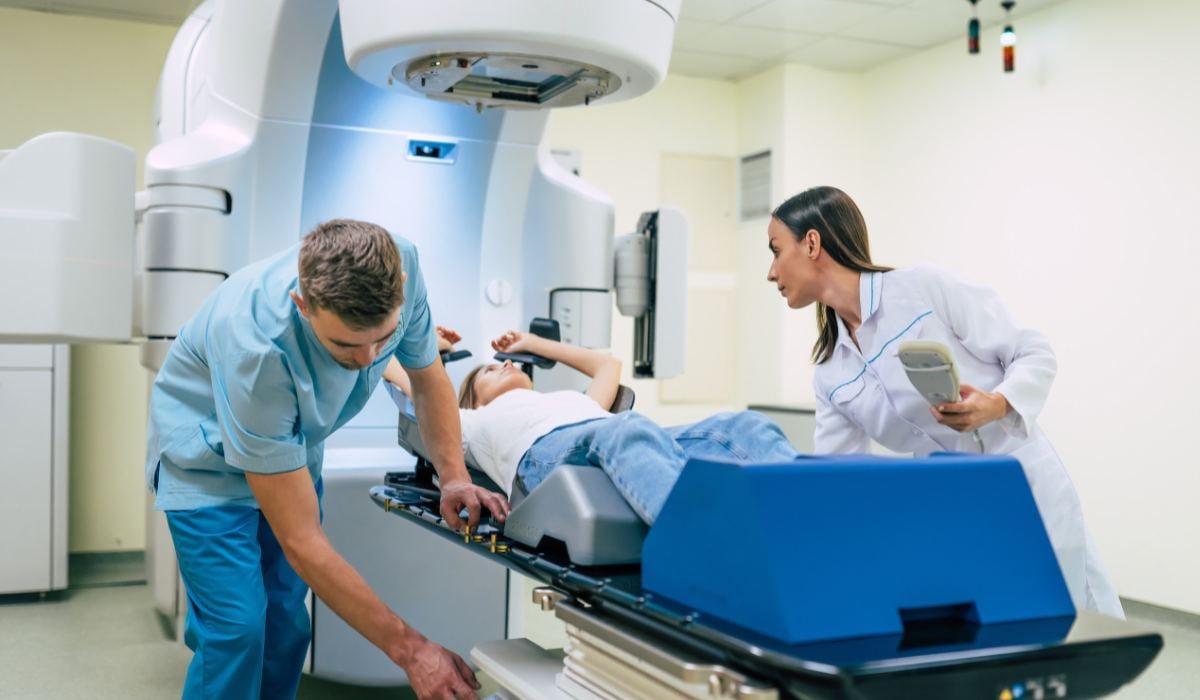
If you or someone you love needs treatment for breast cancer, your oncologist may discuss radiation therapy as one of the treatment options included in your overall plan. Radiation therapy is commonly used after breast surgery to treat breast cancer and it plays an important role in destroying any remaining cancer cells. This significantly reduces the chance of the cancer returning.
There are a few different types of radiation therapy commonly separated into two categories: external beam radiation therapy and internal radiation therapy, also called brachytherapy. Discover the differences between internal and external radiation therapy and how they can be used to treat breast cancer.
What is External Radiation Therapy for Breast Cancer?
External radiation is widely used to treat breast cancer. During external radiation therapy, a machine directs radiation toward the breast from outside of your body.
Before radiation therapy begins, a radiation oncologist and radiation therapists take images of the area receiving radiation. This helps determine the boundaries of the treatment area and target the radiation beams more accurately. The area is marked with tattoos before treatment starts. These tattoos are very small, and you may only have a couple. However, some types of radiation therapy might not require tattoo marks.
When going through external beam radiation therapy, you can expect to lie flat on a table while a machine delivers radiation to the exact spot where the cancer is or was located. The treatment itself is usually painless, but you may experience some side effects afterward. You can expect your provider to take extra care to ensure you lie in the exact same position for each treatment to maintain accuracy.
External radiation can be used in a few ways:
- Whole breast radiation: Targets the entire breast. This method is commonly used after a lumpectomy to ensure no cancer cells are left behind.
- Accelerated partial breast irradiation (APBI): Focuses on the area around where the tumor was removed. This method is suitable for some early-stage cancers.
External radiation for breast cancer is usually given five days per week for several weeks. If hypofractionated radiation therapy is available, it can shorten the total treatment time by a few weeks for many patients. This newer approach delivers the same amount of radiation treatment over a shorter period of time. This is done by using a higher dose in each session. The treatment itself only lasts for a few minutes and is painless.
When is External Radiation Therapy Used for Breast Cancer?
External radiation may be recommended for you in a few different cases, including:
- After you’ve had breast-conserving surgery. The cancer care team is likely to recommend radiation therapy after a lumpectomy to be sure any remaining cancer is destroyed. This lowers the risk of recurrence.
- After you’ve had a mastectomy. Radiation therapy is not always required after a mastectomy since the entire breast is removed, which lowers the risk of recurrence. However, if the tumor is rather large (over 5 cm), radiation may be used to kill any remaining cancer cells in the area.
- When breast cancer has spread to nearby lymph nodes. In this circumstance, radiation may focus on the lymph nodes under the armpit, above the collarbone, and/or near the breastbone.
If your oncologist recommends you have radiation therapy following surgery, it usually begins one or two months after your surgery. This allows the surgical site enough time to heal.
Internal Radiation Therapy for Breast Cancer Treatment
Internal radiation, also referred to as brachytherapy, delivers radiation therapy directly to the site where the tumor is, from the inside of the body. It’s most often used after breast-conserving surgery (lumpectomy).
The radiation oncologist places a small device where the cancer is located in the breast. The device looks like a small tube, and your doctor places radioactive seeds or pellets into this tube for about 10 to 20 minutes. They then remove the seeds from the tube.
This process is repeated several times and usually is done over the course of five days, but treatment times will vary depending on your unique situation.
Internal radiation offers the benefit of being a very effective way to deliver radiation to a specific area of the body, but not everyone will be a candidate for this procedure. Tumor size and its location may limit whether you are eligible for this treatment.
When is Internal Radiation Therapy Used for Breast Cancer?
The American Brachytherapy Society has a set of guidelines that recommend internal radiation therapy:
- If the patient is over the age of 45 and has recently had a lumpectomy, AND
- If the tumor is three centimeters or smaller in size, AND
- If the cancer has not been found in the lymph nodes, AND
- If there are no cancer cells on the rim of healthy tissue that was removed along with the cancer. This is also referred to as “clear margins.”
Important Questions to Ask Your Breast Cancer Specialist About Radiation Therapy
It is important you go into cancer treatment feeling well-informed about what to expect. Before undergoing radiation therapy, you will meet with your radiation oncologist to discuss the process and expected outcome. You should ask about any side effects you can expect, the treatment schedule, and the area of the body that will be treated.
The Latest Radiation Therapy Options for Breast Cancer at Virginia Oncology Associates
Our breast cancer doctors provide the most up-to-date methods of using radiation therapy for breast cancer. Our cancer centers are located throughout Virginia and Eastern North Carolina areas, including Chesapeake, Elizabeth City, Newport News, Norfolk, Suffolk (Obici and Harbour View), Virginia Beach, and Williamsburg. If radiation therapy is part of your treatment plan, it is important to find cancer treatment close to home.





